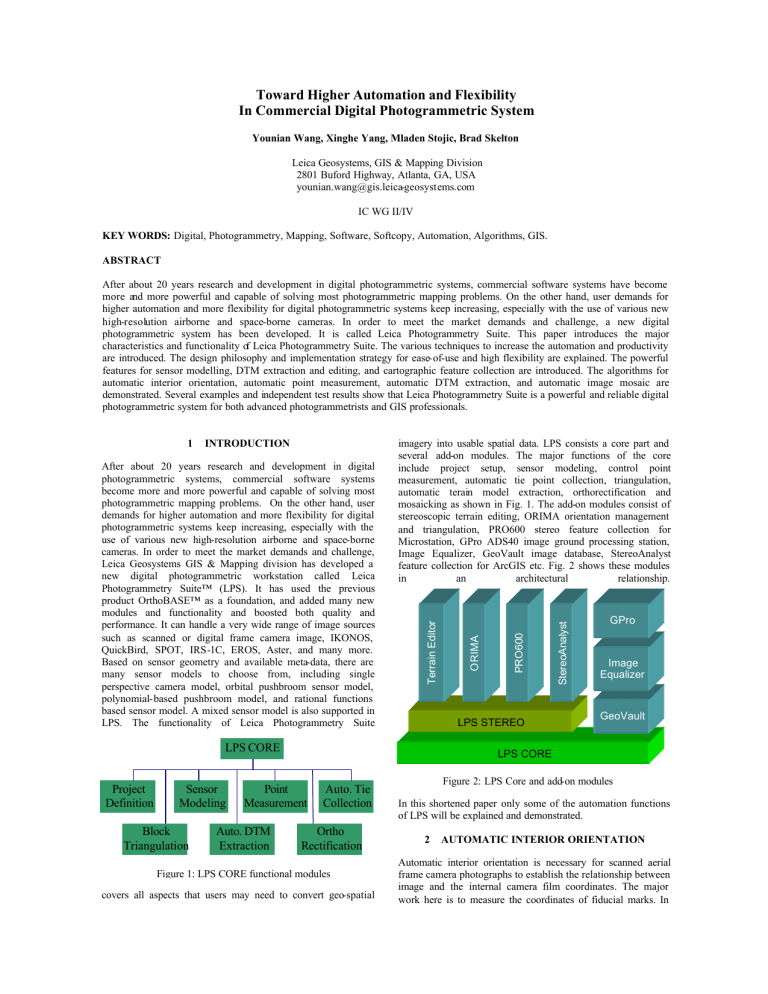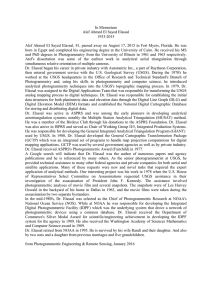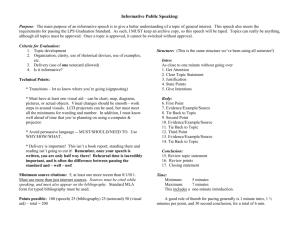Toward Higher Automation and Flexibility In Commercial Digital Photogrammetric System

Toward Higher Automation and Flexibility
In Commercial Digital Photogrammetric System
Younian Wang, Xinghe Yang, Mladen Stojic, Brad Skelton
Leica Geosystems, GIS & Mapping Division
2801 Buford Highway, Atlanta, GA, USA younian.wang@gis.leica-geosystems.com
KEY WORDS: Digital, Photogrammetry, Mapping, Software, Softcopy, Automation, Algorithms, GIS.
ABSTRACT
IC WG II/IV
After about 20 years research and development in digital photogrammetric systems, commercial software systems have become more and more powerful and capable of solving most photogrammetric mapping problems. On the other hand, user demands for higher automation and more flexibility for digital photogrammetric systems keep increasing, especially with the use of various new high-resolution airborne and space-borne cameras. In order to meet the market demands and challenge, a new digital photogrammetric system has been developed. It is called Leica Photogrammetry Suite. This paper introduces the major characteristics and functionality of Leica Photogrammetry Suite. The various techniques to increase the automation and productivity are introduced. The design philosophy and implementation strategy for ease- of-use and high flexibility are explained. The powerful features for sensor modelling, DTM extraction and editing, and cartographic feature collection are introduced. The algorithms for automatic interior orientation, automatic point measurement, automatic DTM extraction, and automatic image mosaic are demonstrated. Several examples and independent test results show that Leica Photogrammetry Suite is a powerful and reliable digital photogrammetric system for both advanced photogrammetrists and GIS professionals.
1 INTRODUCTION imagery into usable spatial data. LPS consists a core part and several add-on modules. The major functions of the core
After about 20 years research and development in digital photogrammetric systems, commercial software systems become more and more powerful and capable of solving most photogrammetric mapping problems. On the other hand, user demands for higher automation and more flexibility for digital include project setup, sensor modeling, control point measurement, automatic tie point collection, triangulation, automatic terain model extraction, orthorectification and mosaicking as shown in Fig. 1. The add-on modules consist of stereoscopic terrain editing, ORIMA orientation management photogrammetric systems keep increasing, especially with the use of various new high-resolution airborne and space-borne cameras. In order to meet the market demands and challenge,
Leica Geosystems GIS & Mapping division has developed a new digital photogrammetric workstation called Leica and triangulation, PRO600 stereo feature collection for
Microstation, GPro ADS40 image ground processing station,
Image Equalizer, GeoVault image database, StereoAnalyst feature collection for ArcGIS etc. Fig. 2 shows these modules in an architectural relationship.
Photogrammetry Suite™ (LPS). It has used the previous product OrthoBASE™ as a foundation, and added many new modules and functionality and boosted both quality and
GPro performance. It can handle a very wide range of image sources such as scanned or digital frame camera image, IKONOS,
QuickBird, SPOT, IRS-1C, EROS, Aster, and many more.
Based on sensor geometry and available meta-data, there are many sensor models to choose from, including single
Image
Equalizer perspective camera model, orbital pushbroom sensor model, polynomial- based pushbroom model, and rational functions based sensor model. A mixed sensor model is also supported in
LPS. The functionality of Leica Photogrammetry Suite LPS STEREO
GeoVault
LPS CORE
LPS CORE
Project
Definition
Sensor
Modeling
Block
Triangulation
Point
Measurement
Auto. Tie
Collection
Auto. DTM
Extraction
Ortho
Rectification
Figure 1: LPS CORE functional modules covers all aspects that users may need to convert geo-spatial
Figure 2: LPS Core and add-on modules
In this shortened paper only some of the automation functions of LPS will be explained and demonstrated.
2 AUTOMATIC INTERIOR ORIENTATION
Automatic interior orientation is necessary for scanned aerial frame camera photographs to establish the relationship between image and the internal camera film coordinates. The major work here is to measure the coordinates of fiducial marks. In
order to increase user’s productivity it is important to automatically recognize and measure the fiducial marks. In LPS a new module has been implement ed to recognize and measure the fiducial marks automatically and precisely. Instead of creating a fiducial template database, user has only to approximately measure one fiducial mark at the beginning.
Then the software will go through each image in the whole project and find all the fiducial marks automatically. The underlying algorithm is a least square template matching.
Therefore the fiducial marks can be found very accurately.
Figure 4a: A registered aerial image (left) and a raw SPOT image (right) with 2 manual tie points
(a) (b)
Figure 4b: Automatically found tie points displayed on their corresponding images
(c)
Figure 3: Automatic Fiducial Measurement. (a) Manually measure one fiducial mark, (b) Automatically measured fiducial Mark with least square template matching, (c) All automatically measured fiducial marks in a strip.
An example is shown in Fig. 3. By using some optimization procedures such as dynamic template size determination, robust fiducial location estimation and hierarchical search, the automatic fiducial measurement process is also very fast. Each image can be finished just in a few seconds with a normal desktop PC.
3 AUTOMATIC POINT MEASUREMENT
Automatic point measurement (APM) includes automatic assistance of ground control point measurement, automatic tie point collection over entire block or sub-block and automatic tie point transfer from one image or sub-block to another. The
APM procedure of LPS includes block connection to set up the relationship between images, feature extraction and matching, and robust gross error checking and least square correlation.
The APM algorithms are independent of sensor type; therefore it works not only with images from aerial cameras, but also with images from digital cameras, non-metric cameras and satellite sensors. Furthermore it is also tolerant of large scale and rotation variations. Therefore the LPS APM can not only be used to connect image blocks for triangulation, it can also be used for various registration purposes, e.g. automatic image warping. The example shown in Fig. 4 demonstrates one of these applications. The left image is a registered aerial photograph; the right image is a SPOT image without any orientation information. These two images have a significant orientation difference and a scale difference about 1: 5.5. They have only a small overlap. The LPS APM can find tie points for this application. The user only needs to measure two tie points manually and approximately in order to give the software
Figure 4c: Enlarged view of three found tie points in their original scale and orientation some initial information about the scale and rotation, then the software will find many accurate tie points for these two images automatically.
4 BLOCK TRIANGULATION
LPS has a core triangulation package and an add-on triangulation module called ORIMA. The core triangulation can handle block triangulation for frame camera geometry, orbital pushbroom geometry and generic sensor geometry. Selfcalibration and robust gross error detection are available in both packages. ORIMA is an extensive triangulation package with stereo point measurement, rigorous GPS/IMU support, advanced error handling and rich residual analysis tools.
Figure 5: ORIMA stereo point measurement interface and graphic point and image connection display
Fig. 5 shows an ORIMA stereo point measurement interface and graphical point and image display.
5 AUTOMATIC DTM EXTRACTION
Automatic generation of terrain models from overlapped images is currently the most important way to collect a DTM.
The DTM extraction module in LPS concentrates on improving the reliability, speed and productivity of the DTM extraction process. In order to improve reliability and speed, an integrated image matching strategy is developed. It includes a featuresupported image correlation, geometric constraints, hierarchical point search, on-the-fly resampling for rotation and distortion compensation, consistency checking etc. For improving speed and productivity, the DTM module can generate DTM’s for all overlapped pairs in the block with the option to automatically mosaic them into a single optimized output. For further flexibility, some easy-to-use graphical interface and tools ar e developed, with which a user can manipulate their image pairs and different interest areas such as excluding regions and strategy parameters very easily and efficiently. It supports variety of input image formats and many output DTM types such as TIN, raster DEM, ESRI 3D shapefile and ASCII.
Furthermore, The LPS DTM extraction module works for
Figure 6a: Graphic overview of the block layout with
GCPs, check points and automatically collected tie points ground points available for the test. LPS APM works well using the provided approximate coordinates of image photographic center. It generates 437 object points with 1477 image points.
The triangulation computation includes automatic gross error detection and 4 additional parameters. 8 of the 14 known ground points are set to be GCP’s and the remaining 6 are used as check points. The root mean square error of 6 check points is
0.041, 0.054 and 0.055 meters for X, Y, Z respectively. The
Figure 6a shows the graphic display of the triangulation results.
It is the footprint of the block with ground point positions and residual vectors. The triangle symbol represents GCP’s, the circle symbol represents check points, and the rectangle symbol represents the automatically collected tie points. (Since the residuals of GCP’s and check points are very sm all, they are difficult to see on the reduced graphic.) Considering the realistic conditions of the block, the accuracy of the triangulation results looks very reasonable. Figure 6b shows the automatically extracted DEM for the whole 28 images with ground cell size 1x1 meters. The whole automatic DEM extraction computation takes less than 30 minutes for 28 images on an ordinary Pentium 4 with 2.4GHz Laptop PC.
Using 383 triangulated tie points (excluding the tie points outside DEM boundary and on buildings and trees) as ground check points, the automatic DEM has accuracy about 0.2 meters. The result shows the automatic DEM process is very fast and accurate.
6 SUMMARY
This paper has introduced a new digital photogrammetric workstation, namely Leica Photogrammetry Suite™. Its main functional modules and system workflow are described. The features and algorithms for sensor modeling, automatic interior orientation, automatic point measurement, block triangulation and automatic DTM extraction of different kinds of images are introduced. Several examples are demonstrated. It shows a powerful, production oriented, process driven and easy to use digital photogrammetric workstation is ready to use for both advanced photogrammetrists and GIS professionals to accurately and efficiently convert their geospatial imagery into usable geospatial data.
ACKNOWLEDGMENTS AND REFERNENCES
To be added.
Figure 6b: Automatically extracted DEM for the whole block with grid size 1x1 meters without any editing all aerial images, digital camera images, video camera images and satellite images, which offers excellent economy for the customer s. Fig. 6 shows an example of a 28- image block used in the OEEPE test. It covers an area of the town Forssa in
Southern Finland. The image scale is 1:4000 and flight height is about 600 meters. The image overlap in strip is 60% and side overlap varies from 24% to 49%. The film is positive color and is scanned as black and white. The pixel size is 30 micrometers; each scanned image has 8000x8000 pixels. There are 14 known




